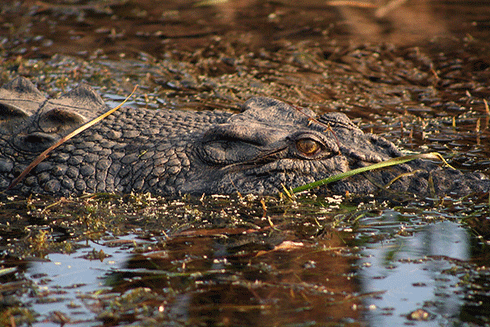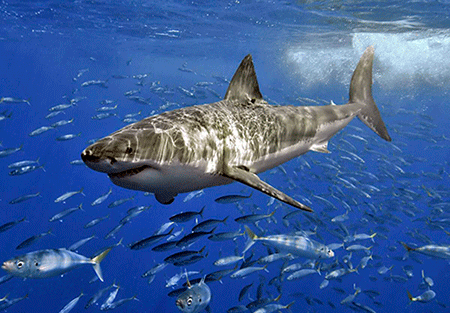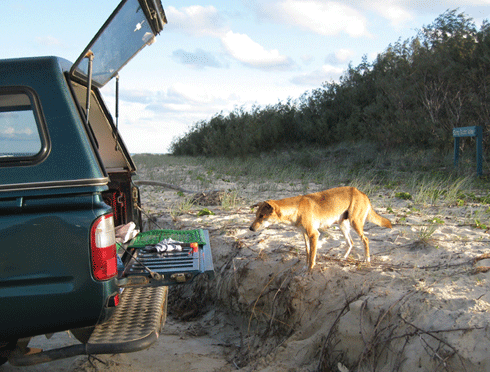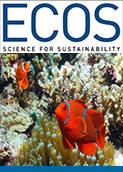
|
Published: 5 November 2014
Managing top predators: culling brings its own set of problems
In October, a young man surfing off the south coast of Western Australia (WA) near Esperance lost an arm and hand in an encounter with what was reported to be a great white shark. Shortly after, baited drum lines (shark hooks suspended from floats anchored to the sea bed) were deployed and two sharks were caught and killed.
Conflict between humans and other so-called 'apex' predators is a source of heated debate in Australia. Three of Australia’s top predators – dingoes, saltwater crocodiles and great white sharks – are protected species under various acts. But all three are also subject to varying degrees of control designed to protect human lives and livelihoods.
Media coverage of the Esperance tragedy reflected the shock that happens when humans confront their status as prey in the food chain.
The use of the drum lines, deployed under WA’s ‘imminent threat’ policy, highlighted an apparent conflict between human safety and environmental conservation. The WA policy allows an exception to the earlier ban on drum lines, imposed after the state’s environmental protection authority deemed them an unacceptable risk to the survival of the south-western great white shark population.
Calls for pre-emptive culling – such as the seasonal use of drum lines off WA surf beaches, or expansion of the Northern Territory’s ‘problem-crocodile’ removal program – inevitably accompany tragedies such as that of the WA surfer.
It’s a familiar scenario that unsettles many scientists. Their response is often to caution that not enough is known about these top predators to be confident that expanding current culling programs is effective, from the perspective of either a human safety or environmental conservation perspective. For example, figures from Queensland’s Department of Agriculture, Forestry and Fisheries show that shark drum-lines caught 667 non-target animals in Queensland waters in the past year, including turtles, dolphins and whales.
Increasingly, scientists are also pointing to evidence that shows that top predators play a vital role in regulating entire ecosystems by inducing trophic cascades, and in so doing are key to maintaining biodiversity throughout the ecosystem.
Trophic (or ecological) cascades occur when a predator changes the abundance and/or behaviour of species across more than one link in a food chain; they can indirectly influence plant communities by suppressing herbivore populations either through predation or by reducing grazing in certain areas.
Dingoes
Despite their status as a protected species, dingoes are subject to local wild dog control measures across Australia’s sheep and cattle grazing country, where they kill and eat livestock, particularly sheep. The measures include poisoning (including aerial 1080 baiting), trapping, and shooting. There is also the dingo fence– at over 5000 km long, the longest continuous fence on earth – which is designed to exclude dingoes from the sheep-grazing lands of south-eastern Australia.
Ecologist Dr Euan Ritchie calls the dingo a ‘biodiversity regulator’.
‘There’s mounting evidence that dingoes regulate ecological cascades in arid and eastern Australia, and that the removal of dingoes results in an increase in the abundance and impacts of herbivores and invasive smaller-bodied predators, foxes and cats,’ says Dr Ritchie.
Dr Ritchie holds out hope that dingoes – and Tassie devils in the case of South Eastern Australia – may be able to prevent Australia’s mammal extinction crisis from worsening.
The mammal species that have undergone the greatest declines in range and abundance are indigenous rodents and ‘medium-sized’ marsupials in the weight range 0.35 kg–5.5 kg. These are common prey for feral cats and foxes.
‘Bilbies are a good example,’ says Dr Ritchie.
‘Recently bilbies have been decimated by a feral cat plague in Queensland. We now know that dingoes can help keep cat numbers down, and cats avoid areas where and when dingoes are most active.
‘So if baiting, shooting and trapping could stop and dingo numbers rise, it’s likely cat numbers would reduce and that would benefit bilbies.’
The role that dingoes play in regulating herbivore populations is also under-appreciated, according to Dr Ritchie.
‘There is good evidence, much of it from studies comparing inside and outside the dingo fence, that dingoes keep kangaroo numbers quite low,’ he says.
An over-abundance of kangaroos can reduce vegetation through grazing to such an extent that it degrades the habitat for native animals, reducing their food supply and cover, making them more vulnerable to predation.
As Dr Ritchie points out, the presence of dingoes reduces the booms in kangaroo numbers after good rain, and the resultant crashes during drought. ‘So that means the system is in a sense more stable,’ he says.
‘From an animal welfare perspective, (the presence of dingoes) is a benefit, because the kangaroos don’t starve to death in lean times, or require culling during boom phases; it also means (kangaroos’) habitat is in better condition.’
He points to another benefit from avoided vegetation loss – the potential for more carbon storage.
‘It’s quite possible that having dingoes in the landscape can mitigate, to some degree, the effects of climate change, just as sea otters appear to in marine environments by reducing overgrazing of kelp by sea urchins‘
Saltwater crocodiles
By the mid 1970s, saltwater crocodiles had become a protected species in the Northern Territory (NT), Queensland and WA, prompted by a severe decline in population numbers following decades of intense commercial hunting.
Since then, the population has recovered substantially, particularly in the NT, where they are now considered almost fully recovered, with populations in most tidal rivers at or near their carrying capacity.
The crocodile conservation program, it seems, may have become a victim of its own success.
Dr Adam Britton of Charles Darwin University works in crocodile conservation management, biology and behaviour.
‘Most people’s memories of crocs from when they were kids were that there were no crocs around, because by the end of the 60s and 70s, crocs had all but disappeared,’ says Dr Britton.
‘So obviously when you went out into the water you wouldn’t have seen crocs. As they return to abundance, the probability that they’ll come into conflict with people increases. Many people are asking why are we bringing this species back to abundance when all they’re good for is eating people?’

|
|
Saltwater crocodile: while not much is known about the ecology of this animal, studies overseas have shown that when caimans, a smaller relative of salties, disappeared from an ecosystem, a trophic collapse was set in train – a boom in the population of the caimans’ prey, crabs, which then decimated the fish larvae on which the crabs fed. Credit: Stephen Michael Barnett under CC BY 2.0
|
Incentive-driven conservation has been key to the conservation effort, along with extensive public education programs about crocodile risk.
For example, harvesting of wild eggs – to restock crocodile farms that rear crocodiles for their skins, which are used in luxury goods – has been permitted since the 1980s in the NT. Dr Britton has been training Indigenous rangers on Queensland’s western Cape York Peninsula, where egg harvest is currently banned, on how to sustainably harvest wild saltwater crocodile eggs.
‘It’s the kind of thing that provides jobs and that link to land and resources that the traditional owners need and want,’ says Dr Britton. He is sure that, as top-order predators, crocodiles have a valuable ecological role to play.
‘No one has really looked at (the crocodile’s role in the ecosystem). There is a huge amount we don’t know about the relationship between crocodiles and their environment. What we do know about the relationships between top predators and their environment is that if you take out the predators, it has a massive knock-on effect.’
However, we do have tantalising clues as to their role from other species in other countries.
‘There is a classic case that is often cited when this comes up, although it was published in a non-peer-reviewed publication. The causal relationship, which was not investigated, is credible but hard to prove.
‘When a particular population of black caiman alligators was wiped out from a lake in Venezuela, suddenly the fish species that the local community depended on crashed.
‘The caimans had been previously blamed for eating these fish, but what came to light was that the juvenile caiman were preying on small freshwater crabs, and the freshwater crabs were preying on fish eggs. So the assumption is that when the caimans were taken out, the crab population increased, and so did predation of the fish eggs.’
Great white sharks
White sharks were listed as vulnerable in the late 1990s. CSIRO’s Barry Bruce says this is due to their high susceptibility to population decline and low capacity to replenish numbers if significant declines occur.
‘They grow slowly, need to reach a large size before they reproduce, and produce low numbers of pups (baby sharks),’ says Mr Bruce.
He has run a tagging program at sites in eastern Australia (central NSW and southeast Victoria), South Australia and Western Australia for over a decade. This has filled in some of the gaps in our understanding of the movements of these animals.
‘The more tagging and monitoring we do, the more we will understand what drives movement patterns, but we will probably never be able to say with certainty how long any individual shark may stay in any one place’.

|
|
As is the case with saltwater crocodiles, we know little about the ecology of great white sharks, but scientists warn that healthy ecosystems will rely on the continuing presence of apex predators such as these. Credit: Terry Goss under CC BY-NC-SA 2.0
|
And there are still big gaps in the knowledge about population size and trends. ‘There are no reliable measures of historic population size and no reliable measures of current population size.
‘Several of the key pieces of information needed to model population numbers (to see if they are going up or down) are still lacking.’ This missing information includes how often the sharks breed, how long they live, and how many juveniles and adults survive from year to year.
Mr Bruce’s team is applying a DNA fingerprinting technique – developed by CSIRO during research on tuna – that will help fill these gaps.
In the meantime, he warns that we generally know too little about marine ecosystems to reliably predict what might happen if great whites were to disappear from our ecosystems.
‘Modelling has predicted some unusual consequences of removing top-order predators where some species in the ecosystem increase and some decrease in number with flow-on effects. The bottom line is that healthy ecosystems (which we rely on for food and from which we reap enormous benefit via tourism and recreation) need adequate numbers of top-order predators.’




